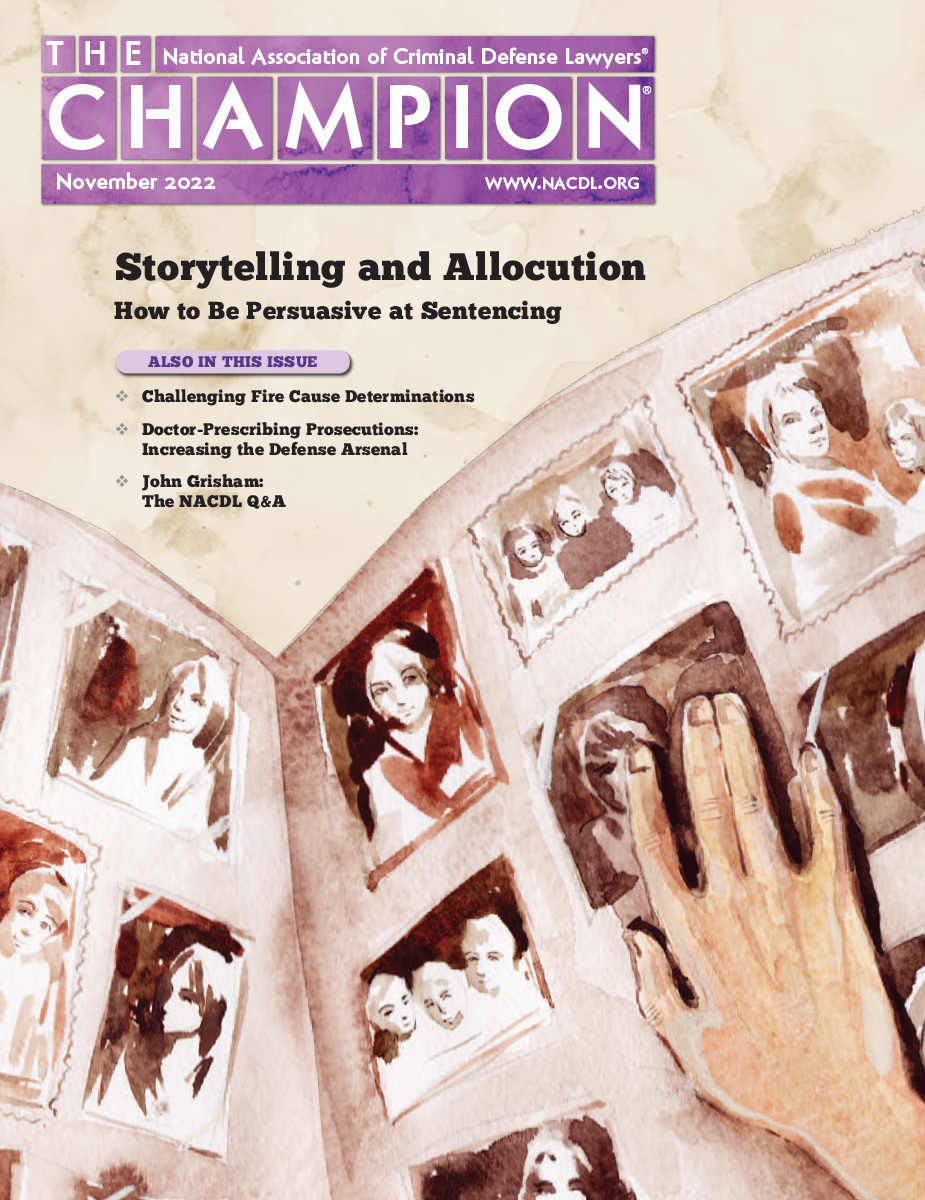November 2022

Defense attorney Andrew Mishlove offers five rules that serve as a guide to effective sentencing presentations. Also this month: The NACDL Q&A features bestselling author John Grisham.
Articles in this Issue
-
A Model for Challenging Fire Cause Determinations
The aftermath of an accidental fire can often look the same as the aftermath of an intentionally set fire. This confounding fact has led to many false accusations. John Lentini writes that an arson determination should be viewed with great skepticism if it is based on (1) “low burning,” (2) a fire that burned “hotter than normal” or “faster than normal,” or (3) the appearance of “pour patterns” on a floor without a positive finding of an ignitable liquid in a laboratory test.
-
Affiliate News
What events are NACDL affiliates hosting this month? Find out here.
-
From the President: Rolling Up Our Sleeves and Fighting the Death Penalty
Jury verdicts represent statements of the community. Respect for a jury’s verdict should not be something about which we need to remind Americans.
-
In Memoriam: A Legacy of Uncompromising Excellence: A Tribute to Jim Shellow
Joe Bugni reflects on the influence of NACDL Past President Jim Shellow.
-
NACDL News: NACDL Applauds Historic Presidential Pardons to Address Failed War on Drugs
NACDL News for November 2022
-
NACDL News: NACDL Renews Calls for Nationwide Reforms to Use of Jailhouse Informants
NACDL News for November 2022
-
NACDL News: NACDL Renews Demand for Rikers Remedy
NACDL News for November 2022
-
Perspective: America’s Jails Are in Crisis: Elected Officials Should Visit Them
Prisons and jails in the United States are in crisis. Staff shortages and other chronic problems have resulted in institutions that are unsafe to live and work in for prisoners and correctional officers alike.
-
Saving Hippocrates: The Supreme Court and the CDC Add to the Defense Arsenal
in Doctor-Prescribing Prosecutions
Doctors can breathe a partial sigh of relief after the decision in Ruan v. United States; the U.S. Supreme Court held that prosecutors must show more than mere negligence or malpractice to make a felon out of a physician. In addition, new guidance from the Centers for Disease Control and Prevention on opioid prescribing promises to make it much harder to prosecute – and easier to defend – doctors.
-
Storytelling and Allocution: How to Be Persuasive at Sentencing
Defense attorney Andrew Mishlove offers five rules – one for defense counsel and four for the client – that serve as a guide to effective sentencing presentations. He writes that a persuasive sentencing presentation encompasses the client’s complete existence, which means it must address the aggravating factors and expose the mitigating factors in the context of an entire human life. How can defense counsel tell a story that puts the crime in context?
-
The NACDL Q&A: Always Fighting Something Bigger: Conversation With a Storyteller
When he practiced law, John Grisham represented working people and those accused of crimes. How did his legal career influence his writing life? If he could change one law, which one would he change? NACDL Executive Director Lisa M. Wayne takes a few moments to get inside the head of her favorite author.
-
Verbatim: The BOP Listening Session
A listening session sponsored by the Federal Bureau of Prisons provided an opportunity for NACDL to share its concerns with Bureau staff members on multiple topics of interest.
